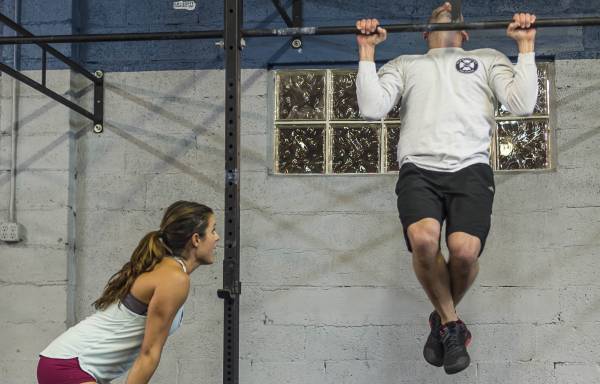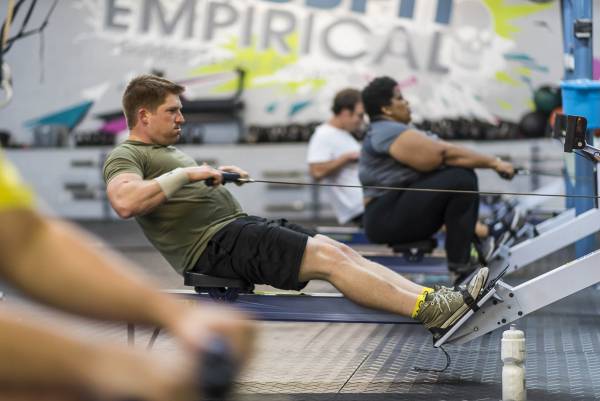Who remembers their first CrossFit workout?
For me it was “Cindy” in a hotel gym, and it kicked the living crap out of me. I’d never felt my muscles ache so much or my lungs burn so bad. I peeled myself off the floor after about ten minutes and said, “That was awesome!”
What I didn’t know was that training like that all the time is the worst thing you can do for your fitness.
Train Like Rich
How do we ensure we’re training properly? By coming up with a pacing strategy, just like Rich Froning. Froning never starts fast, never jumps out the gate, but keeps a steady pace throughout. We can’t replicate Froning’s genetics or his lifestyle, but we can definitely replicate his strategy.
Rich Froning looking determined and composed at the 2014 CrossFit Games
The following four pacing rules apply to metcons. They take a little time to engrain, but not as much time as you’d think. After a few weeks, you’ll naturally begin to figure out what speed you can hit a workout at to give you the best time of the day and the best training effect overall.
1. Panic Breathing Rule
The first and easiest rule is to avoid panic breathing, where you feel you have to breathe rather than feeling in control of your breath. Wall balls are a great example of a movement that induces this.
Listen to your body, and stop before you have to. Spend a couple of metcons noting when you get too out of breath, and then next time stop just short of that. Once you’ve stopped, compose yourself, then carry on.
“It’s not enough to just slow down a little bit, as you have to give your body time to catch up to the excess workload it’s just had to perform.”
2. Heart Rate Rule
We generally start blowing up when our heart rate exceeds 155bpm for experienced CrossFitters or about 140bpm if you’re new. At this point, we’re producing waste quicker than our bodies can flush it out.
The next time you’re performing a gassy metcon, take a moment to check whether your pacing is on point. Stop and take your pulse for 6 seconds every 2 minutes:
- If the count is 12 beats in those 6 seconds, it roughly correlates to 120bpm. You need to speed up a bit.
- 14-15 beats you’re bang on target
- More than 15 beats, you need to slow way down.
It’s not enough to just slow down a little bit, as you have to give your body time to catch up to the excess workload it’s just had to perform.

Through checking your heart rate during a WOD once in a while, you’ll get a good idea of what appropriate pacing feels like. Repeat this simple test any time you want to reassess your pacing strategy.
This rule works best for workouts where there’s little to no muscular fatigue or technique fall-off. In other words, where there’s not a lot else to stop you other than blowing up.
3. 40% Rule
For bodyweight work, never do more than forty percent of your maximum capacity in any one burst. Sometimes you may be working closer to twenty percent, particularly if it’s a high volume workout (think “The 100s” at Regionals). If you’ve 10 strict pull ups, never do more than 4 in one go. If you’ve 20 pull ups to do, you’re better off doing 5 sets of 4 with 20 seconds rest. Rest periods between 15-30 seconds work best for developing your gymnastic tolerance.
This only really works if you bother to time your rest. If you guess your rest, you’ll rest too short in the beginning and too long at the end. Use the clock.
4. Total Volume and the Last Round Rule
An easy error fall into is looking at just one round in isolation, and thinking “I could do it all unbroken.”
Remember, you’re not doing one round, you’re doing a bunch of rounds, so you’ve got to look at the complete picture. There’s no point starting fast and losing more time later on in the workout than you would have “lost” by taking suitable early rest periods.
“The average CrossFitter loses about 10-30 seconds per workout break, depending on the exercise and what you do.”
The biggest counterargument to this rule is, “Yeah, but I felt good at the start.” Let me tell you a story about Trevor. We were doing “Helen” (3 rounds of 400m run, 21 kettlebell swings, 12 pull ups). I’d spoken about total volume and the last round rule.
Trevor was a pretty experienced CrossFitter and had done Helen multiple times. We knew he was consistent on the runs and he could swing a kettlebell all day long. So we looked at the pull ups and decided that 6 and 6 was a consistent strategy.

Round one, he hit 12 unbroken pull ups. “Hmmm” I thought to myself, wondering where this would go. Round two, he hit 6, 3, 2, and 1. Round three, he hit 4, 3, 3, and 2 to finish.
The average CrossFitter loses about 10-30 seconds per workout break, depending on the exercise and what you do. Trevor took 15 seconds on average and took six total breaks, equaling 90 seconds. Had he gone with our initial strategy, he would have only taken three breaks. He would have taken 45 seconds off his “Helen time” – not by being any fitter, just by being smarter.
How Do You Know If You’ve Paced Right?
Take the example of a three-round workout:
- Round one should feel like you’re going way too slow and you have a strong urge to just fire on ahead.
- Round two should feel like you’re perfectly pacing.
- The final round should feel like you’re barely able to get the work in with the determined workload/rest interval
What Does It Mean If Your Strategy Fails?
- If you failed before the halfway point, you can safely say your strategy was too ambitious. Next time, start slower and/or with fewer reps. If you did three handstand push ups every 20 seconds, try three every 30 seconds, or two every 20 seconds.
- If your strategy fell apart towards the end, keep the same strategy next time with the aim of holding it for the entire workout.
- If your strategy worked perfectly, next time look to reduce rest, perform larger sets, or move a little more quickly without blowing up.

I often hear that thinking and training like this is not fun. Sometimes you want to just hit a workout and see what happens. I agree there’s a time for that, and you’ve got to enjoy your training.
But all I know is that it’s not fun failing to finish a workout. It’s not fun starting great and then being reduced to having to take a minute break just to attempt one more rep. And it’s certainly not fun when you look back after six weeks or six months and realise your times haven’t improved and your max reps haven’t gone up.
- If your strategy worked perfectly, next time look to reduce rest, perform larger sets, or move a little more quickly without blowing up.
- If your strategy worked perfectly, next time look to reduce rest, perform larger sets, or move a little more quickly without blowing up.
- If your strategy worked perfectly, next time look to reduce rest, perform larger sets, or move a little more quickly without blowing up.
There is a great sense of accomplishment in looking at a workout, figuring out a strategy, and executing it. Then knowing you’ve done your absolute best at it.
As a much smarter coach than me said, “Success is peace of mind, which is a direct result of self-satisfaction in knowing you did your best to become the best you are capable of becoming.”
Enjoy this? Read these:
- Don’t Be One of These 7 Types of Sneaky CrossFitter
- PB Your Fran Time With These 8 Easy Fixes
- How to Build Your Athlete’s “Battery”
- What’s New on Breaking Muscle UK Today
Photo 1 ©2014 CrossFit, Inc. Used with permission from CrossFit, Inc.
Photo 2 courtesy of Shutterstock.
Photo 3 and 4 courtesy of CrossFit Empirical.






